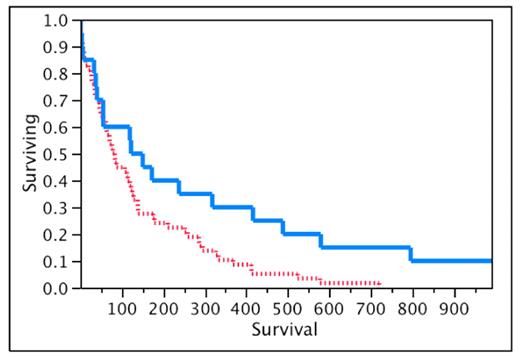Abstract
Deletion 5q in Acute Myeloid Leukemia (AML): a Clinicopathological Description of 79 Cases From a Single Institution
Rafael Santana-Davila, Shernan G. Holtan, Rhett P. Ketterling, Ryan A. Knudson, David P. Steensma, Dong Chen, James D. Hoyer, Curtis A. Hanson, Ayalew Tefferi.
Background: Deletion 5q (del(5q)) is a lenalidomide-sensitive cytogenetic abnormality commonly seen in patients with myeloid disorders. In this study we analyze the clinicopathological characteristics of patients with AML and del(5q).
Methods: Patients with del(5q) and AML were identified through a database query of our institutional cytogenetic database from May, 1992 through December, 2005. Both peripheral blood and bone marrow specimens from each patient were morphologically examined by a hematopathologist (DC, JDH and/or CAH). A morphologic diagnosis was given based on current WHO criteria. A critical review of the patient history was performed for each patient.
Results: A total 79 patients were identified. Median age was 71 (range 39–87) years, 56% (n=43)were female. The most common subtype according to the FAB classification was M2 (n=23, 29%). In 35 (44%) patients AML developed a median of 9.4 (range 1–294) months since the diagnosis of a pre-existing myeloid malignancy, of which myelodysplastic syndrome accounted for 24 (9 cases of MDS NOS, 6 of RA, 6 of RAEB1, 2 of RAEB-2, and a single RARS), a myeloproliferative neoplasm in 10 (4 cases of a CMPD NOS, 4 cases of PV and a single case of ET and PMF each) and 1 case of a prior history of AML with a t(8;21). The del(5q) was documented in 7 of this 24 patients in the antecedent hematologic disorder. Neither a history of prior exposure to cytotoxic agents nor a prior myeloid disorder was found in 44% (n=35) of the patients. Del(5q) was commonly associated with a complex karyotype (n=67), however in 9 patients it was found to be the sole abnormality. The most frequent breakpoint was q13q33 (n=47) followed by q15q33 (n=12). Initial pathological description did not identify any morphological abnormalities in 6 cases, in contrast myelodysplasia involving at least two cell lines was appreciated in 58% (n=46) of the patients. The median survival was 2.8 months. The majority of the subjects (n=51, 65%) received palliative treatment, 7 patients were lost to follow up and no treatment information was available for review and the remaining 21 received induction chemotherapy with a curative intent, in this group median survival was 8.8 months with 52% (n=11) of patients achieving a complete response. Surprisingly the only factor that appeared to alter survival in the whole group was the presence of the breakpoint in chromosome 5 being distal to q15 (median 2.8 vs 4.1 months, p=0.025)
Conclusions: This study constitutes the largest review of del(5q) in AML, its presence is currently associated with advanced age and a poor survival. Close to half of the patients in our series were classified as de novo AML. Although more commonly encountered as part of a complex karyotype it can also be present as a single abnormality. The different cytogenetic characteristics of the del(5q) may impact survival and this deserves further investigation.
Survival of patients with AML and del(5q) in which the breakpoint was found to be distal to q15 (straight line) compared with patients in which the breakpoint was proximal to q13 (dotted line).
Survival of patients with AML and del(5q) in which the breakpoint was found to be distal to q15 (straight line) compared with patients in which the breakpoint was proximal to q13 (dotted line).
Disclosures: No relevant conflicts of interest to declare.
Author notes
Corresponding author


This feature is available to Subscribers Only
Sign In or Create an Account Close Modal